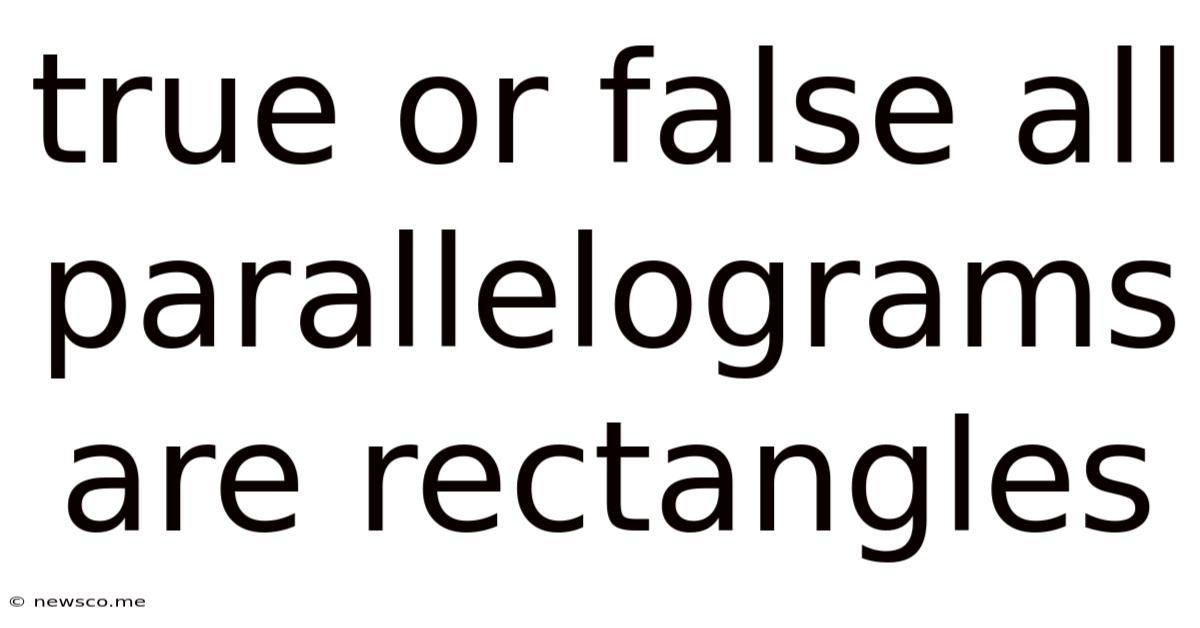True Or False All Parallelograms Are Rectangles
News Co
May 08, 2025 · 4 min read

Table of Contents
True or False: All Parallelograms Are Rectangles?
The statement "All parallelograms are rectangles" is false. While all rectangles are parallelograms, the reverse is not true. This seemingly simple geometric concept often causes confusion, so let's delve deeper into the definitions, properties, and differences between parallelograms and rectangles to fully understand why this statement is incorrect.
Understanding Parallelograms
A parallelogram is a quadrilateral (a four-sided polygon) with specific properties:
- Opposite sides are parallel: This is the defining characteristic. The opposite sides are equidistant from each other and will never intersect, no matter how far they are extended.
- Opposite sides are congruent: This means the opposite sides have equal length.
- Opposite angles are congruent: The angles opposite each other have equal measure.
- Consecutive angles are supplementary: This means that the sum of any two adjacent angles is 180 degrees.
Think of a parallelogram like a slanted rectangle. It maintains the parallel sides aspect but doesn't necessarily possess the right angles that define a rectangle. This crucial difference is the key to understanding why not all parallelograms are rectangles.
Examples of Parallelograms
Many shapes fall under the parallelogram umbrella. Besides rectangles, we have:
- Rhombuses: Parallelograms with all four sides of equal length. Think of a diamond shape.
- Squares: Special cases of both rhombuses and rectangles, possessing four equal sides and four right angles.
- Rhomboids: Parallelograms with unequal adjacent sides and no right angles. This is perhaps the most obvious example that illustrates the distinction between parallelograms and rectangles.
Understanding Rectangles
A rectangle is a quadrilateral with the following properties:
- Four right angles: This is the defining characteristic of a rectangle. Each angle measures 90 degrees.
- Opposite sides are parallel: This inherits from the parallelogram definition.
- Opposite sides are congruent: Again, inherited from the parallelogram definition.
The crucial difference between a parallelogram and a rectangle lies in the angles. Rectangles must have four right angles. Parallelograms only require opposite sides to be parallel. This difference in the angle requirement is fundamental.
Visualizing the Difference
Imagine pushing on one side of a rectangle. You will distort it, changing the angles, but the opposite sides will remain parallel. You've now created a parallelogram (perhaps a rhomboid), but it's no longer a rectangle because those crucial right angles are gone.
The Venn Diagram Analogy
To further clarify, consider a Venn diagram:
- The larger circle represents all parallelograms.
- The smaller circle, entirely within the larger circle, represents all rectangles.
This visual demonstrates that all rectangles are parallelograms (they sit inside the parallelogram circle), but not all parallelograms are rectangles (there's a significant area in the larger circle outside the smaller one).
Mathematical Proof of the False Statement
A mathematical proof can definitively show that the statement "All parallelograms are rectangles" is false. We can use a counterexample:
Consider a parallelogram with angles measuring 60 degrees, 120 degrees, 60 degrees, and 120 degrees. The opposite angles are equal, and the consecutive angles add up to 180 degrees, fulfilling the requirements of a parallelogram. However, it lacks the 90-degree angles required for a rectangle. Therefore, this parallelogram is not a rectangle. The existence of even one counterexample is sufficient to disprove the universal statement.
Common Misconceptions
The confusion often stems from the overlapping properties. Since rectangles possess all the properties of parallelograms plus the right angles, people mistakenly assume the reverse is true. It's like saying all squares are rectangles (which is true), but not all rectangles are squares (which is also true). The extra condition (all sides equal) in the definition of a square differentiates it from a rectangle. Similarly, the 90-degree angle condition differentiates rectangles from general parallelograms.
Applying the Knowledge
Understanding this distinction is crucial in various fields, including:
- Engineering and Construction: Accurate geometric knowledge is essential for building structures that are stable and structurally sound. Knowing the differences between parallelograms and rectangles ensures the proper application of calculations and construction techniques.
- Computer Graphics and Game Development: The accurate representation of shapes and their properties is vital in creating realistic and functional virtual environments.
- Mathematics and Geometry: A strong grasp of geometric definitions is fundamental for advancing in more complex mathematical concepts.
Key Takeaways
- The statement "All parallelograms are rectangles" is definitively false.
- Rectangles are a subset of parallelograms. They possess all the properties of parallelograms plus four right angles.
- The defining characteristic separating parallelograms from rectangles is the presence of four 90-degree angles.
- Understanding these differences is important in multiple fields requiring geometric accuracy.
This detailed explanation should solidify the understanding that while all rectangles are parallelograms, the reverse is not true. The crucial difference in their defining properties makes this a fundamental concept in geometry. Remember the visual analogy of the Venn diagram to easily grasp this important distinction. The existence of parallelograms that are not rectangles effectively disproves the initial statement.
Latest Posts
Latest Posts
-
How Many Weeks To The End Of The Year
May 08, 2025
-
What Is The Length Of Hj
May 08, 2025
-
How Are Factors And Multiples Related
May 08, 2025
-
Which Expression Is Equivalent To 2 4
May 08, 2025
-
How Many Sides Does Regular Polygon Have
May 08, 2025
Related Post
Thank you for visiting our website which covers about True Or False All Parallelograms Are Rectangles . We hope the information provided has been useful to you. Feel free to contact us if you have any questions or need further assistance. See you next time and don't miss to bookmark.